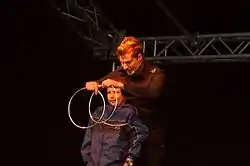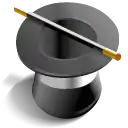Chinese linking rings
The Chinese linking rings is considered to be a classic of illusion magic. In the traditional effect, solid metal rings appear to link and unlink, pass through each other, and form chains and other complex patterns and configurations. The rings may even be handed out to audience members for examination. Sometimes an audience member is invited onto the stage to perform alongside the magician as part of a "do as I do" routine.
History

Chinese stage magician Ching Ling Foo (1854–1922) was one of the early performers of the linking rings in the form known today. A painting by Giacomo Mantegazza in 1876 showed a harem girl holding a set of rings above her head. Speculation about the rings' origin has been traced to Turkey, Egypt and the Middle East and as long ago as the 1st century.
French magician Philippe (Jacques Andre Noel Talon) was one of the first recorded magicians to use the rings. During the second half of his show, he donned an Oriental robe and conical cap. He took 8-inch (200 mm) solid metal rings and had the audience examine them. He claimed that he learned them from a troupe of Chinese jugglers in Britain. After the rings were returned, Philippe proceeded to link and unlink them. From there he made combination of glittering circles into complicated designs. According to Robert-Houdin, he said that for a finale, Philippe blew on them and they fell separately on the floor.[1] Robert-Houdin also performed a version of the trick.
Recent magicians who are known for their performances with the linking rings include Dai Vernon,[2] Richard Ross,[3] Jack Miller, Michael Skinner, Whit Haydn, Ian Ray - "The Genie Ali Pali", Jeff McBride, Shoot Ogawa, Fu Manchu, Tina Lenert,[4] Fábio De'Rose, Jim Cellini, Chris Capeheart,[5] Tom Frank, and Galina.[6] Christian Bale's character, Alfred Borden, performs the trick in The Prestige. The number of rings used can vary from two to ten, or more. A standard set of commercially available rings typically includes eight rings.
In 1988, Japanese magician Masahiro Yanagida performed with miniature Ninja rings, using four rings that were four and a half inches (or 11.43 cm) in diameter. Since then, the Chinese linking rings have also become a favourite performance item for close-up magicians.
Rings
A quality set of eight linking rings can be obtained from a supplier of magic props. Most consider 8-inch-diameter (200 mm) rings to be the smallest size suited for stage performance, while 12-inch (300 mm) rings are common; 15-inch (380 mm) rings are also available, but rarely seen in use. Larger sizes are often constructed from stainless steel tubing for the best combination of durability and weight. Professionals may wish to have a set of larger-diameter rings for use on a stage, or a "close-up" set of rings in the 4–5-inch (10–13 cm) range.
Many magicians look for rings that make a nice ringing tone when they strike each other.
See also
References
- Illustrated History of Magic by Milbourne Christopher (1973), ISBN 978-0690431650
- "Dai Vernon - Linking Rings". YouTube. 6 October 2008. Retrieved 20 October 2017.
- Christian de MIEGEVILLE (19 May 2012). "Richard Ross "Music-hall "Théâtre de l'Empire Paris Avril 1982". YouTube. Retrieved 20 October 2017.
- Tina Lenert (16 November 2009). "Tina Scarf&Rings". YouTube. Retrieved 20 October 2017.
- ChrisCapehart (25 November 2010). "ChrisCapehartLinkingRings.avi". YouTube. Retrieved 20 October 2017.
- Glyn Davies (27 October 2007). "Galina part 1 - Linking Rings". YouTube. Retrieved 20 October 2017.
Other sources
- Whit Haydn, Comedy Four-Ring Routine, DVD
- Harlan Tarbell, Tarbell Course in magic.
